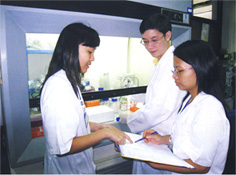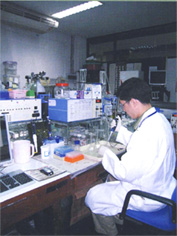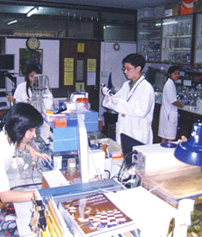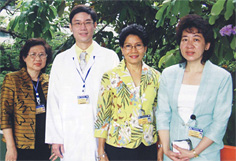|
 Assistant
Professor Dr. Narattaphol Charoenphandhu
was born on the 26th of April 1978
to Dr. Rongphol Charoenphandhu, former
Permanent Secretary of the Prime Minister’s
Office and the Secretary General of
the Cabinet, and Mrs. Nitra Charoenphandhu
(Naigowit). He received his secondary
education from the Assumption College,
and in 1995 enrolled in the Faculty
of Medicine Siriraj Hospital. After
joining the Mahidol University’s
Medical Scholars Program, he graduated
with a B.Sc. in Medical Science (Hons.)
from the Faculty of Science in 1999
with a senior project on the bioelectrical
characteristics of epithelium under
the supervision of Professor Emeritus
Liangchai Limlomwongse. In 2001, he
was awarded a Ph.D. in Physiology
with Dean’s List prize from
the same institution under the supervision
of Professor
Nateetip Krishnamra, a TRF Senior
Research Scholar. In 2002, he resumed
clinical study at the Faculty of Medicine
Siriaj Hsopital and graduated M.D.
(Hons.) in 2004. Assistant
Professor Dr. Narattaphol Charoenphandhu
was born on the 26th of April 1978
to Dr. Rongphol Charoenphandhu, former
Permanent Secretary of the Prime Minister’s
Office and the Secretary General of
the Cabinet, and Mrs. Nitra Charoenphandhu
(Naigowit). He received his secondary
education from the Assumption College,
and in 1995 enrolled in the Faculty
of Medicine Siriraj Hospital. After
joining the Mahidol University’s
Medical Scholars Program, he graduated
with a B.Sc. in Medical Science (Hons.)
from the Faculty of Science in 1999
with a senior project on the bioelectrical
characteristics of epithelium under
the supervision of Professor Emeritus
Liangchai Limlomwongse. In 2001, he
was awarded a Ph.D. in Physiology
with Dean’s List prize from
the same institution under the supervision
of Professor
Nateetip Krishnamra, a TRF Senior
Research Scholar. In 2002, he resumed
clinical study at the Faculty of Medicine
Siriaj Hsopital and graduated M.D.
(Hons.) in 2004.
 Dr. Narattaphol joined the Department
of Physiology, Faculty of Science,
Mahidol University as a lecturer in
2005, and has been an Assistant Professor
in Physiology since 2007. His main
mission is to produce advanced research
works on calcium metabolism concurrently
with teaching medical students of
the Faculty of Medicine Ramathibodi
Hospital. Dr. Narattaphol has contributed
significantly to publications from
the Consortium
for Calcium and Bone Research (COCAB),
of which Professor Nateetip Krishnamra
is the founder and present director.
He receives supports from the TRF-CHE
Research Grant for New Scholar and
the Research Career Development Grant
(TRF Research Scholar), and is also
supported by grants from COCAB and Professor Nateetip’s TRF
Senior Research Scholar grant. He
has published 17 articles in international
journals, including 4 publications
in the prestigious high-impact American
Journal of Physiology. All publications
represent research performed entirely
in Thailand, and have Dr. Narattaphol
as the first of corresponding author.
In addition, he is a reviewer for
several international journal, such
as Bone and Biochimica et Biophysica
Acta. At present, Dr. Narattaphol
together with Professor Nateetip supervise
20 laboratory members, i.e., 14 graduate
students, 1 post-doctoral fellow,
3 post-master fellows, and 2 technicians. Dr. Narattaphol joined the Department
of Physiology, Faculty of Science,
Mahidol University as a lecturer in
2005, and has been an Assistant Professor
in Physiology since 2007. His main
mission is to produce advanced research
works on calcium metabolism concurrently
with teaching medical students of
the Faculty of Medicine Ramathibodi
Hospital. Dr. Narattaphol has contributed
significantly to publications from
the Consortium
for Calcium and Bone Research (COCAB),
of which Professor Nateetip Krishnamra
is the founder and present director.
He receives supports from the TRF-CHE
Research Grant for New Scholar and
the Research Career Development Grant
(TRF Research Scholar), and is also
supported by grants from COCAB and Professor Nateetip’s TRF
Senior Research Scholar grant. He
has published 17 articles in international
journals, including 4 publications
in the prestigious high-impact American
Journal of Physiology. All publications
represent research performed entirely
in Thailand, and have Dr. Narattaphol
as the first of corresponding author.
In addition, he is a reviewer for
several international journal, such
as Bone and Biochimica et Biophysica
Acta. At present, Dr. Narattaphol
together with Professor Nateetip supervise
20 laboratory members, i.e., 14 graduate
students, 1 post-doctoral fellow,
3 post-master fellows, and 2 technicians.
 The
ultimate goal of Dr. Narattaphol’s
work is to answer the question of
– how to help Thai people have
strong and healthy bone? This question
should bring awareness to the future
risk that comes with aging population
and should be included in the public
health policy. Aging is accompanied
by degenerative diseases, especially
metabolic bone diseases which are
expensive to treat and eventually
lead to morbidity and mortality. To
optimize efficiency of the prevention
and treatment, one needs full understanding
of the mechanism of the overall calcium-regulating
system. To achieve his goal, Dr. Narattaphol
has adopted both vertical and horizontal
approaches to multidisciplinary research.
For the vertical approach, he uses
various available techniques, e.g.,
organ transplantation, electrophysiology,
radionuclide tracer, bone histomorphometry,
dual-energy X-ray absorptiometry,
confocal fluorescent microscopy, molecular
cloning and microarray, to elucidate
in depth the calcium-regulating machinery.
He has proposed a novel theory pertaining
to the transepithelial calcium transport
in the intestine, as well as the optimal
calcium concentration for effective
calcium absorption. His findings can
be applied to improve forms of calcium-fortified
tablets and calcium-enriched diet,
and to mitigate osteopenia or osteoporosis
in patients with chronic metabolic
acidosis or in lactating women. The
ultimate goal of Dr. Narattaphol’s
work is to answer the question of
– how to help Thai people have
strong and healthy bone? This question
should bring awareness to the future
risk that comes with aging population
and should be included in the public
health policy. Aging is accompanied
by degenerative diseases, especially
metabolic bone diseases which are
expensive to treat and eventually
lead to morbidity and mortality. To
optimize efficiency of the prevention
and treatment, one needs full understanding
of the mechanism of the overall calcium-regulating
system. To achieve his goal, Dr. Narattaphol
has adopted both vertical and horizontal
approaches to multidisciplinary research.
For the vertical approach, he uses
various available techniques, e.g.,
organ transplantation, electrophysiology,
radionuclide tracer, bone histomorphometry,
dual-energy X-ray absorptiometry,
confocal fluorescent microscopy, molecular
cloning and microarray, to elucidate
in depth the calcium-regulating machinery.
He has proposed a novel theory pertaining
to the transepithelial calcium transport
in the intestine, as well as the optimal
calcium concentration for effective
calcium absorption. His findings can
be applied to improve forms of calcium-fortified
tablets and calcium-enriched diet,
and to mitigate osteopenia or osteoporosis
in patients with chronic metabolic
acidosis or in lactating women.
 For the horizontal approach, Dr. Narattaphol
has applied knowledge in physics,
chemistry, material science and computer
science to develop working models,
e.g., bio-physical modeling, direct
current (DC) circuit and impedance
analyses and computational programming,
to explain how calcium is transferred
from diet to bone. In addition, he
works with other young scientists
to use atomic force microscopy and
nanoindentation to evaluate bone strength
at the nano scale. He also starts
new fields of research in bone calcium
metabolism in Thailand, such as the
neural control of bone function, improvement
of the trabecular bone strength at
the micro and nano levels by non-impact
exercise (e.g., swimming), and the
theoretical concept of bone membrane.
Dr. Narattaphol postulates that bone
cells can form bone membrane which
regulates calcium exchange between
blood and bone, and may be a novel
therapeutic target for reducing bone
loss. Because of its scientific merit,
this work has recently been published
in the Histochemistry and Cell Biology,
a journal with the highest impact
factor in the microscopy area. For the horizontal approach, Dr. Narattaphol
has applied knowledge in physics,
chemistry, material science and computer
science to develop working models,
e.g., bio-physical modeling, direct
current (DC) circuit and impedance
analyses and computational programming,
to explain how calcium is transferred
from diet to bone. In addition, he
works with other young scientists
to use atomic force microscopy and
nanoindentation to evaluate bone strength
at the nano scale. He also starts
new fields of research in bone calcium
metabolism in Thailand, such as the
neural control of bone function, improvement
of the trabecular bone strength at
the micro and nano levels by non-impact
exercise (e.g., swimming), and the
theoretical concept of bone membrane.
Dr. Narattaphol postulates that bone
cells can form bone membrane which
regulates calcium exchange between
blood and bone, and may be a novel
therapeutic target for reducing bone
loss. Because of its scientific merit,
this work has recently been published
in the Histochemistry and Cell Biology,
a journal with the highest impact
factor in the microscopy area.
|

